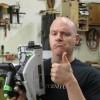Everyone probably agrees that "level of sharpness" attainability is higher now than ever before in history right?
If you ever tried shaving with a dull straight razor you would know they had to have a way of getting those sharp for our forefathers to go without facial hair.
The "secrets" of sharpening were likely held close to home among the tradesmen of old. It was a tactical advantage in a competitive world to have an edge on your competition.
Dave Weaver mention a jasper hone at one time. I bummed a piece of jasper from my wife's rock hoard. It is very hard and can put a mirror on steel.
It is imaginable in the past young craftsmen tried every rock they could find to see what it could do to steel.
jtk
"A pessimist sees the difficulty in every opportunity; an optimist sees the opportunity in every difficulty."
- Sir Winston Churchill (1874-1965)





 Reply With Quote
Reply With Quote

 They are certainly flat enough to sharpen your plane iron and chisels with.
They are certainly flat enough to sharpen your plane iron and chisels with. 




